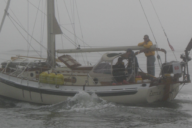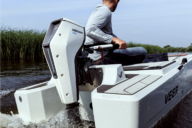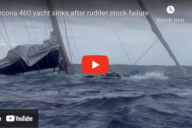Hi George –
It sounds like we have similar approaches to harnesses and alcohol on board during passages. Regarding harnesses, my boat rule is that anytime we have to hang on to something to move around the cockpit, we harness up. AND at night the first thing we do when exiting the saloon is to hook up, regardless of the conditions. Period. No exceptions. We’re on board a 47’ cat, so perhaps easier to move around a bit.
We have one drink a day – usually in conjunction with dinner. Just one. At my discretion the crew can have extra – which would be during mild conditions. Secure upon arrival at the end of a passage, everyone is required to sip a rum no matter the hour….
Over the years we have settled on a formal watch system only at night. Ad hoc during the day except when in “crowded” sea ways when specific watch standers seem prudent.
Galley duty is generally ad hoc – take turns. We’ve had the luxury of having personal acquaintances and family as crew – no strangers – and suspected slackers are not on board…..
Capt Dave Nelson
S/V Pas de Deux
Catana 471-44
Currently in Little Creek, VA waiting for weather to passage south
George,
I thought this was a great piece on personal choice. Like you, I have been on boats that have been wet and dry, one that didn’t allow music (not even ear buds in your bunk), and one that was Kosher. I politely followed the rules set by each skipper and bite my tongue when the really weird rules pop up out of nowhere.
My boat has 3 main rules; Don’t fall overboard, don’t plug the head, and don’t get drunk. Drinking on passage is always weather dependent. I will modify the “rules” depending on the experience of the crew and where we are going. Typically, we share a sundowner after dinner since the entire crew is awake and hanging out together. When at anchor everyone can indulge, but extreme moderation is recommended. We can party hard and shake our money-makers when securely tied up in the marina.
PFDs with tethers are mandatory at night and during rough weather. I actually make one friend wear a PFD anytime the wind is above 15 knots or when riding in the dinghy. She can’t swim and falling overboard and learning in the cold waters of Lake Superior is not recommended.
I run a pretty laid back boat and don’t harp on the rules unless someone is really acting like a fool. Fortunately for me, the people I sail with understand actions have consequences so we rarely have issues. I always tell people the “rules” I set are because I not only like to take people out sailing, I also like to bring them back.
Cheers!
Tim Hanrahan
Pfds always at night and no one goes to foredeck without someone else topside. Jack lines and harness when going forward at night or anytime offshore. Lastly: don’t drink and jib! In other words, dry boat if we’re underway.
Andy Sonis
SV Sowwanin II
Sabre 456
Sent from my iPhone.
Andrew L. Sonis, DMD
George,
You provide a clear description of your approach, and we do just as you describe on passage. I thoroughly enjoy your publications sail, and power. The technical engine and system articles are especially valued.
Best regards,
John Bell
I own my boat with some friends and we tend to appoint a skipper for the day who guides the routine. Generally, we maintain a watch of some sort, change of helm and meal prep sort of thing. But by consensus we do not drink when not tied up or at anchor. Mainly because we like a drink and are aware of the consequences. We are all somewhat older (average age well over 60 ) and generally wear our lifejackets and insist on clipping on when alone on deck. This is because we know how difficult it is to get someone back aboard.
Regards
Bill Giles
Hi George,
I found your article Grog and Harnesses interesting………as a sailor of slightly above average competence and an owner of 2 boats, one in Greece the other in the UK, I 100% agree with your views !
Harnesses at night whatever the conditions…….and in Greece they can change very rapidly, and during the day in inclement conditions, that said if the forecast is mixed I have them out and to hand.
Grog….best kept for harbours and anchorages, if drifting along on a calm pleasant evening then maybe a tipple is therapeutic
otherwise no, keep it for later ! Drink in the atmosphere instead !!
Cheers,
Peter Litchfield
UK
George,
I’m sure you will get many vociferous replies to your latest blog. I think you are absolutely correct that a good skipper will fall somewhere between the lines. However I felt compelled to write, because an author in your position has a responsibility to encourage others to proceed with best practice, and your latest could, I feel, encourage others to think that PFDs are OK offshore, and drinking on passage is ok, “because George does it, so therefore I can”!
In my experience, drinking on passage dulls the senses, slows response times, and makes it more difficult to stay awake on watch, However, I’m not overly strict about it, and typically I find that the crew follow my lead, i.e. not drink, but if others (who are not about to go on watch), feel that a sundowner will help them, then I will not stop them (with limitations vis quantity, conditions and so on).
I prefer to maintain crew moral by having a crew meal together with everyone in the cockpit, before sundown, so that all the dishes are washed and everything is put away before the sun has gone down.
However when it comes to PFD’s I am more pedantic. Firstly your terminology, a PFD is ONLY and can only ever be a Personal Floatation Device. By law it is only required to have a 50N rating, i.e. will keep something weighing just 5 kilos (11 lbs) afloat, and is only designed for swimmers in protected waters, where assistance is to hand. It is not a life jacket, which is what you are refering to, and photographed wearing. A life jacket can have a 100N, 150N or 275N rating.
For offshore sailing the minimum I would insist upon would be 150N. i.e. would keep a person weighing 15 kilos (33 lbs) afloat.
NB a 100kg (220 lbs) person (wearing no clothes) would weigh 5kg (11 lbs) in water. So with wet foul weather gear etc, 150N should be considered the minimum. The rescue services etc all wear 275N rated life jackets.
My rule on life jackets, as opposed to PFDs is similar to yours, in that typically we only wear them at night or when things are a bit fruity. However, I do have three very strict rules.
- Life jackets should be tried on and fitted (whilst wearing the gear you will be wearing for the trip), with a tight chest band (try swimming with one on and you will come to realise that tight is not tight enough, even with crotch straps it must be very secure), and
- each individual on board is responsible for keeping their life jackets in an easy access location personal to them (i.e. not in a locker full of life jackets), most tend to keep their life jackets in their bunk, or tucked in their boots, and
- when offshore, anyone leaving the cockpit for whatever reason, should put on a life jacket.
My reasoning for rule 1 is obvious, if the life jacket is going to lift up and smother your face when you are in the water it is pointless,
My reasoning for rule 2, is when the s&*T hits the fan, it happens very quickly. If everyone tries to recover their life jackets from a single locker all at the same time, mayhem will ensue.
Rule 3, because you are more likely to trip over something as you move out of the cockpit, and typically on ocean passages you are sailing downwind. Downwind sails typically would take longer to stop the boat and turn around should someone go over.
To convert this into a real scenario, in 2012, in perfect downwind sailing conditions mid-Atlantic (900 miles from any shore), following a whale strike, the entire crew were able to don life jackets in super quick time with minimum fuss, whilst we assessed our situation. Following that experience, I would still maintain the same rules with regards to life jackets. I only carry PFDs for kayaking and SUPing!
Safe sailing and Fair winds
Fiona
s/v Ruffian












